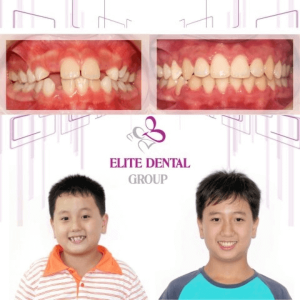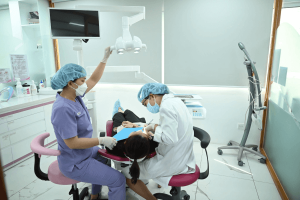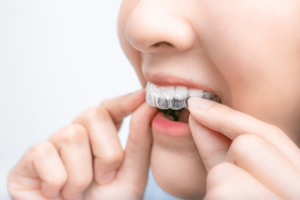Table of content
Braces are a method to correct dental and jaw misalignments, providing a new, healthy, and attractive smile. For optimal results, the braces process is crucial. So, what steps make up a standard braces procedure? Are there any essential pre- and post-bracing care tips? Let’s dive into the details!
1. Braces – The best method to correct dental misalignment
Braces use dental devices to position teeth correctly, correcting issues like protruding, recessed, or crooked teeth. This not only optimizes bite alignment for comfortable chewing but also brings a bright and confident smile.
For effective and safe results, the braces process must be overseen by experienced orthodontists, adhering to the Ministry of Health’s standards.
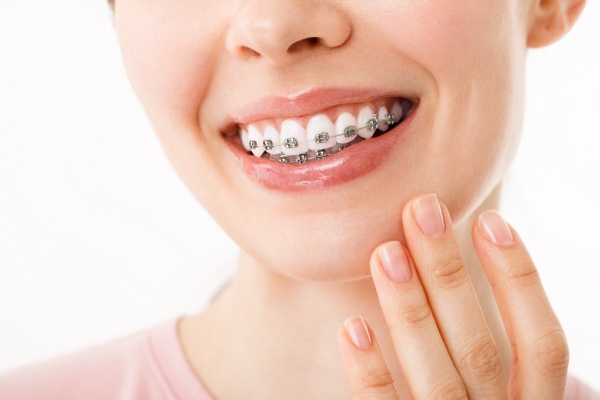
2. How does the braces process work?
The braces process typically lasts 18–24 months, depending on individual dental conditions, with several stages involved.
The stages of bracing include:
- Initial consultation and Treatment planning: The orthodontist assesses the patient’s goals, dental history, and dental misalignments. After that, X-rays, cephalometric radiographs, and photographs of the mouth and face are taken for diagnostic purposes.
- Alignment phase: Brackets and wires of increasing sizes are used to align the teeth. Depending on the dental condition, the alignment phase can last from 2 to 6 months or longer. If necessary, teeth may be extracted or filed to create room in the arch, ensuring the best orthodontic results.
- Bite adjustment: Using special devices like springs, elastics, mini-implants, or loops, the orthodontist refines tooth alignment for optimal bite function over 4–8 months, depending on the case.
- Removing braces and wearing a retainer: Once teeth are fully aligned with a functional bite, braces are removed. A retainer is then worn for 1–2 years to keep the teeth stable in their new position, preventing any movement.
3. Steps in a standard braces procedure
A complete braces process consists of five steps, with treatment duration depending on the individual’s dental condition and cooperation.
3.1 Bracket braces process
The bracket braces process includes the following steps:
Step 1: Comprehensive dental examination and X-rays
First, a complete dental examination and X-rays assess the patient’s dental condition—whether teeth are crowded, spaced, misaligned, etc. Additional imaging may also be used, including:
- Intraoral and facial photography.
- Cephalometric and panoramic X-rays to assess the overall view of the teeth and jawbone.
- Additional PA X-rays may be taken if there is any horizontal asymmetry.
- Take periapical X-rays when specific tooth conditions need to be examined, and CBCT (Cone Beam CT) may be used to investigate abnormal structures or unerupted teeth.
- Dental impressions may be taken if necessary for study purposes.


Step 2: Treatment consultation and Impressions
After choosing the appropriate type of braces, a treatment plan is proposed. Impressions are taken to create customized brackets or trays. For narrower arches, the dentist may recommend using a palatal expander or other appliances to widen the arch in preparation for the next steps, such as space creation and bracket placement.
Step 3: Bracket attachment
Securing brackets is a critical step. The orthodontist monitors progress and makes adjustments as necessary to ensure the teeth are moving as planned.
Step 4: Regular check-ups
Patients need regular check-ups to monitor tooth movement and bite alignment:
- For bracket braces: Monthly appointments.
- For invisible aligners: After every 3–4 aligners.

Step 5: Removing braces and retainer wear
Once alignment is complete, braces are removed, and a retainer is worn to keep the teeth stable. Additionally, patients can undergo various cosmetic treatments such as teeth whitening, veneer bonding, gum contouring, and scaling to achieve a beautiful, flawless smile.
3.2 Invisible aligners process
There are many different methods for braces, including traditional metal braces, ceramic braces, and invisible aligners. Among these, invisible aligners are considered the most advanced orthodontic technique, using a series of transparent trays made from a special biocompatible plastic material. This method offers a comfortable, pain-free experience, is safe, and allows for easy removal for brushing and eating.
To provide a comfortable and effective treatment experience, Elite Dental has fully standardized the invisible aligners process into 7 steps:
Step 1: Examination and consultation with the dentist
First, patients undergo a dental examination and X-rays, along with intraoral and facial photos. A detailed treatment plan is then developed with the orthodontist.
Step 2: 3D digital dental impressions
To ensure accurate, quick, and time-saving aligner production, Elite Dental uses Trios 3D digital scanning technology, capturing precise, high-resolution images of the entire dental arch.
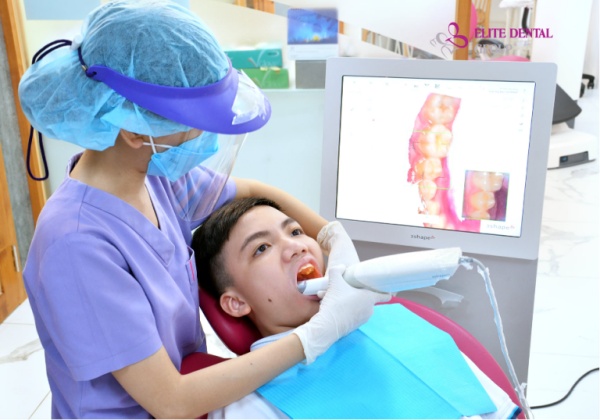
Step 3: Treatment plan preview with ClinCheck
With all necessary information gathered, the orthodontist will create a tailored treatment plan and simulate it using ClinCheck. Patients can review the treatment plan and visualize how their teeth will move, as well as the number of trays required.
Step 4: Custom tray fabrication
Once the treatment plan is confirmed, the orthodontist sends the data to Align Technology for tray production. Each patient receives a personalized set of aligners that are used throughout the treatment.
Step 5: Receiving and wearing the trays
After approximately 3 to 4 weeks, the trays are delivered, and the patient returns to the clinic for fitting and instructions on how to use and care for the trays.
Step 6: Regular Checkups
Every 4 to 6 weeks, patients return to Elite Dental for checkups to monitor progress and receive new sets of trays.
Step 7: Completion and Retainers
Once all trays have been used, the treatment is complete. To maintain long-term results, patients will be instructed to wear retainers for about 6 months.

4. Important notes pre- and post-braces
To ensure a smooth treatment and shorten the process, patients should keep the following in mind:
4.1. Pre-braces
4.1.1. What is the best age for braces?
Many wonder if there is an age limit for braces. The answer is that anyone aged 5 to 50 can get braces. However, Elite Dental advises that the ideal age for the best results, in terms of bite, teeth, and facial aesthetics, is between 5 and 15 years old when children are losing and replacing their baby teeth.
Are parents aware of the optimal age for their children to begin orthodontic treatment? The practice of orthodontics has become increasingly widespread, yet not everyone realizes that beginning treatment at the right age can significantly reduce the duration of treatment and yield the best possible results. Therefore, in order to…
4.1.2. Which braces method should you choose?
Depending on your dental condition and health, different methods of braces may be suitable. It’s important to consult thoroughly with an orthodontist to choose the right treatment.
4.1.3. Where should you get braces?
Orthodontic treatment is specialized, requiring precision to achieve a proper bite and straight teeth. Clear aligners, in particular, require a significant investment, and the results depend heavily on the dentist’s expertise. That’s why it’s essential to choose a reputable clinic with experienced orthodontists before starting your journey to a confident smile.
Since its founding in 2012, Elite Dental has become a trusted, specialized orthodontic center, with many satisfied clients praising its standout qualities:
- Elite’s orthodontists have in-depth knowledge of dental and jaw structures and extensive practical experience with both metal braces and clear aligners. After a thorough examination, they develop personalized treatment plans to correct misalignments, ensuring the best final results — a healthy, beautiful smile.

- Elite Dental follows a “Maximum preservation of natural teeth” philosophy, recommending extractions only when absolutely necessary. This approach helps maintain your natural teeth and long-term oral health.
- Orthodontic appliances, including wires, brackets, and clear aligners, are all guaranteed to be high-quality, imported from abroad. This is crucial in ensuring smooth treatment without side effects or allergic reactions.
- At Elite, modern equipment is used throughout the process, including 3D Trios scanners, ClinCheck software, and Sirona X-ray machines, providing a comfortable and precise treatment experience.
For over 12 years, Elite has helped many clients overcome dental misalignments, improving the aesthetics of their smiles and boosting their confidence in life and work.
One example is Ms. B.T. (born in 1984), who shared with Elite that her crowded teeth made her self-conscious and hesitant to engage in conversations, affecting her work. After two years of treatment with Elite, her teeth were beautifully straight, her bite aligned, and her confidence restored. This transformation helped her succeed professionally and gain more opportunities.
4.2. Post-braces
After removing braces, oral care becomes crucial to avoid any unwanted complications that could affect treatment outcomes:
4.2.1. Follow-up appointments as per the doctor’s advice
Regular dental check-ups are mandatory during orthodontic treatment. These visits allow doctors to monitor tooth movement and intervene if the teeth are not shifting according to the treatment plan.
4.2.2. Use of retainers
Wearing retainers for the correct and sufficient amount of time helps maintain the results of orthodontic treatment and ensures the teeth remain stable.
4.2.3. Pay attention to your diet
After removing braces, the teeth may still be sore, so it’s best to avoid hard or chewy foods. Opt for soft foods like porridge, soup, milk, and boiled or stewed dishes to help the teeth gradually adjust.
4.2.4. Oral hygiene and care post-braces
This step is equally important at the end of the orthodontic process. If the teeth are not cleaned properly, plaque and tartar can build up, leading to bad breath, tooth decay, or gum diseases. It’s recommended to replace toothpicks with dental floss and use an interdental brush and mouthwash daily to maintain strong, healthy teeth.
With the information provided, we hope you now have a better understanding of the orthodontic process. Throughout the treatment phases, it’s important to follow the doctor’s instructions and adhere to oral care recommendations to ensure your treatment proceeds as planned and delivers the best results. For more information, contact Elite Dental:
COSMETIC & ORTHODONTIC DENTISTRY CENTER
- 75 Huynh Tinh Cua, Vo Thi Sau Ward, District 3, HCMC
- Hotline: 0902661100


